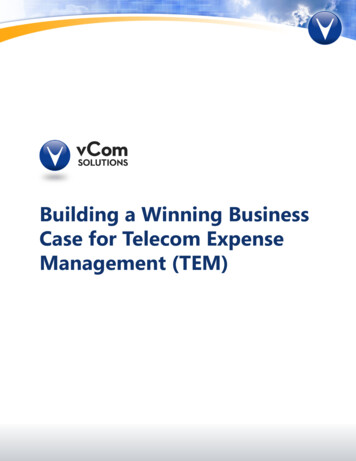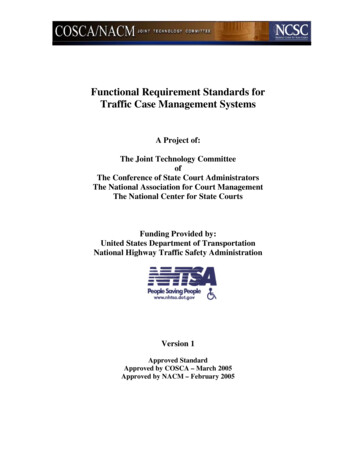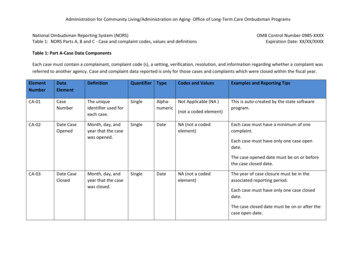
Transcription
Building a Winning BusinessCase for Telecom ExpenseManagement (TEM)
INTRODUCTIONWith diverse geographical footprints, expanding communication needs, and a proliferation of carrier partnersoffering variable plans, rates, and services, companies today face an ever-growing set of challenges in their questto properly monitor and manage their telecom expenses. What lines are in inventory? Are costs being managedeffectively? How can we avoid the productivity drain and wasted expense?For many companies, the answer lies in new-breed telecom expense management (TEM) solutions that leverageintelligent software tools to manage inventory and monitor costs to maximize the organization’s telecominvestments. TEM solutions automatically untangle the invoices and telecom lines, allocate costs correctly, andidentify opportunities for savings.But before they undertake a TEM initiative, companies are wisely analyzing their telecom environments anddemanding careful assessments of the costs and benefits of TEM solutions. The following white paper highlightsthe various considerations and factors that should be components of any thorough and thoughtful business case.ASSESS YOUR NEEDSA well-developed business casebegins with a thorough assessment ofyour complete telecom lifecycle. Askyourself – and your key stakeholders– some of these key questions.How are you managing the telecomenvironment – expenses, inventory,and processes? Do you have the righttechnology to efficiently managethat environment? What are yourmanagement costs – and how dothey compare to your peers andcompetitors? What information ismissing that would improve telecommanagement?Fig. 1: The Keys to Managing the Telecom Lifecycle:Assess your needs from these important perspectivesvCom Solutions - Building a Winning Business Case for Telecom Expense Management (TEM)Page 1
The goal is to create a holistic perspective of the entire telecom environment and its impact across the entireorganization. Perhaps you want to replicate pricing advantages from one carrier to other carriers. Maybe youhave good contracts in place – but no tools to audit the invoices to ensure carrier compliance with terms andconditions. You might even sense that escalating trouble tickets can be a challenge because you don’t always haveupdated contact information for various networks, services, and providers. Here are six important dimensions tobuild into your TEM needs assessment: Sourcing – Do you use multiple carriers and vendors? Are you devoting proper time and resources tobenchmarking their performance – financially and operationally? Do you regularly review contracts over thelife of the relationship? Procurement – How are you placing orders with your various carrier partners? Testing and deployment, ofcourse, can require considerable investments of time and resources. Assess your organization’s level of expertiseto complete that process efficiently and cost-effectively. Inventory Management – It’s challenging to track the dozens or hundreds of different telecom lines. Youneed to know which are active – and identify dormant lines that can be silent cost centers. Many companiesattempt to tackle this problem with static spreadsheets (calling their carrier partners to get specs and typingthem into spreadsheet cells, for instance). That takes time, limits your visibility, and prevents effective reportingand analysis. Service – Simply tracking the various service issues among a range of carriers is a time-intensive headache formost organizations. Contacting different service desks to track trouble tickets and request escalations can leadto unnecessary delays. Each carrier’s process is different and changes frequently. Invoice Management – This should be an area of emphasis. How doesthe accounting team granularly track invoices from all of the differentcarriers and code them into your AP system to properly allocatecosts? How well can your accounting team consult IT regardingsignificant variances in invoices? Business Intelligence – Businesses need both a big-pictureperspective to spot trends and the ability to drill down to identifyand remediate exceptions and variances. That requires the ability toaggregate charges across carriers into a single format.vCom Solutions - Building a Winning Business Case for Telecom Expense Management (TEM)Page 2
ESTABLISH YOUR DIRECT AND INDIRECT SAVINGS OPPORTUNITIESAfter you’ve pulled together a comprehensive assessment of your current telecom environment, you’ll still needsome specific data points to begin to assess your savings opportunities. Number of Service Providers – How many carriers is your organization using for wireline and wireless services? Invoices – How many invoices are you processing each month? Spending – What’s the annual cost of your organization’s telecom services? Tracking – At what level are you tracking your telecom expenses – at the office level? Region? Department?Employee? And how do your managers get visibility into their organization’s telecom spend?Gathering this data will help you determine thescope of benefits that can accrue from a TEMsolution deployment. What is the impact ofTEM on the typical organization? While no twocompanies are alike, Aberdeen Group estimates thateffective TEM can reduce overall annual telecomcosts by as much as 26 percent. Gartner Groupestimates a range of 19-54 percent savings from thevarious aspects of a TEM program (see Fig. 2).Calculating the SavingsYour business case should reflect the savings thatare available in two areas – direct (lower rates,eliminating unused services, and fixing billingvariances) and indirect (by saving the labor costsassociated with reviewing and coding invoices andreducing support calls).Cost Reduction from TEM5-12%2-7%Rate assurance3-8%1-15%CONTRACT MANAGEMENT8-12%USAGE MANAGEMENTInVENTORY RECOGNITIONONGOING AUDITFig. 2: Source: Gartner GroupThe Cost of Invoice ProcessingAberdeen estimates that – by the timeit’s touched all of the stakeholders andcompleted the total payables workflow –the average invoice costs the organization 63-70 each in processing costs. If youhave 100 invoices each month, you’respending roughly 80,000 annually juston tactical payment. That doesn’t evenconsider the time spent analyzing invoicesand identifying savings opportunities.vCom Solutions - Building a Winning Business Case for Telecom Expense Management (TEM)Page 3
So what benchmarks and metrics can you use to estimate the direct and indirect savings that are availablethrough TEM? Using the Gartner and Aberdeen studies as well as vCom Solutions’s own data acrosshundreds of clients, the following conservative estimates are reliable for a company with 500,000 inannual telecom expenses:Direct Savings Assumptions 15 percent reduction in telecom rates 6 percent reduction in costs by eliminating billing errors 4 percent savings by eliminating unused inventoryIndirect Savings Assumptions: 60/hour loaded labor costEliminate 1.5 days/month of invoice account codingEliminate 1.5 days/month reviewing invoicesSave five days/month on service callsBreakdown of savings through TEM ( 500,000 annual spend) 28,800man hours on . . . . . . . . . . . . . . . . . . . . . . . . .SUpport Calls. . . . . . . . . . . . . . . . . . . . . 75,000Lower rates5.8% 8,640man hoursreviewing invoices . . . . . . . . . . 8,640 . . . . . . . . . .man hours codingfor accounting1.7%15% 171,000First-yearSavings1.7%6% 30,000 . . . . . . . . . . . . . . . . . . . . . . . . .eliminatingbilling erroRs 20,000eliminating unused. . . . . . . . . . . . . . . . . . . . . . . . . services4%As an example, for an organization with an annual telecom spend of 500,000, TEM can generate a firstyear savings of 171,000. But that still leaves two important questions to address before a proper ROI can becalculated: Does this reflect your organization’s telecom annual spend levels? And given the cost associated withTEM – how do you determine a net-benefit figure?vCom Solutions - Building a Winning Business Case for Telecom Expense Management (TEM)Page 4
CALCULATING THE RETURN ON INVESTMENTNaturally, a TEM solution requires some investment from the organization. For the purposes of this paper,two cost levels are assumed: 1,000/mo. for organizations with lower annual telecom expenditures and 2,000/mo. at the high end. There’s also one template blank for you to insert your own estimated cost andto calculate your own ROI.Typical ROI Calculations for Various Levels of SpendingAnnualTelecom Spend 250,000Direct SavingsPercent25%25%Direct SavingsPer Year 62,500 2,500,000 5,000,00025%15%115% 125,000 250,000 375,000 750,00078101316 480 480 480 480 480 3,360 3,840 4,800 6,240 7,680 40,320 46,080 57,600 74,880 92,160 102,820 171,080 307,600 449,880 842,160Annual TEMInvestment 12,000 12,000 12,000 24,0002 24,000NetSavings 90,820 159,080 295,600 425,880 818,160757%1326%2463%1775%3409%Indirect Days SavedPer MonthCostPer DayCostPer MonthLabor SavingsPer YearTotal TEMSavingsROI 500,000 1,000,0001. In this model, the percentage of direct savings declines as annual telecom spending increases because companies with larger annual telecomspending typically have already achieved some measure of savings through volume purchasing of telecom services. Smaller companies experiencehigher levels because they have, typically, been unable to enjoy the benefits of aggregated-volume purchasing.2. This model assumes that a larger level of TEM investment is required by companies with larger annual telecom budgets.vCom Solutions - Building a Winning Business Case for Telecom Expense Management (TEM)Page 5
YOUR ROI CalculationsA B CYourannualtelecomspendD E FDirectDirectNumberSavings Savings per of Dayspercentyearsaved perassumptionmonthInsert figure25% %AxB Insert# daysG HIJKYOURROILaborCostper DayLaborCost PerMonthLaborSavingsPer avings 480DxEF x 12G C 12,000H-Idays J Ix 100%As the tables show, each month that you delay implementing a TEM solution, your organization is wastingthousands or hundreds of thousands of dollars in unnecessary telecom expenses. However, beyond eventhese direct and indirect costs, there are additional latent opportunities that also indirectly affect yourbottom line. For instance, the ability to identify chronic support issues – whether it’s a specific location,service offering, carrier, or other factor – can represent important efficiencies and lower costs. TEM can alsoautomatically comb through invoices to identify savings opportunities and give you the visibility into yourspending that can create greater accountability among users and managers.Improved data means improved decision making. You can generate usage and spending reports that canhelp justify infrastructure investments in services like voice over IP (VoIP).TEM DEPLOYMENT OPTIONSNot surprisingly, there a few basic models for implementing a TEM solution. Each presents its ownadvantages.Pay for Professional ServicesThis “a la carte” model has evolved and succeeded because it offers important value to organizations. Inthis model, a team of experienced consultants acts as your representative to conduct carrier negotiations tomaximize your rate savings. They perform telecom benchmarking, invoice auditing, and other key servicesthat save money.vCom Solutions - Building a Winning Business Case for Telecom Expense Management (TEM)Page 6
Software-OnlyIn this model, your organization licenses either an on-premise software solution or subscribes to a cloudbased solution. In either scenario, your organization is charged with rolling out the software to usersand actively using the solution on an ongoing basis to monitor carrier performance and billing. It offersan expense profile that is largely predictable but also requires a certain level of expertise within yourorganization to derive the maximum value.Hybrid ModelMore recently, some TEM providers are blending professional services and software, subsidized by thesavings generated through carrier negotiations and aggregated purchasing power. Client companies avoidbig-ticket software purchases or big-bill monthly consultant invoices by tapping into those cost-savingsbeing generated by the consultancy. This also provides a rigorously agnostic approach to carrier selectionand eliminates the headaches and time of juggling multi-carrier pricing and contracts. Instead, theorganization has one single-source telecom vendor with unified support and operations – masking the costmanagement and support complexities beneath.SECURING STAKEHOLDER BUY-INAfter you’ve completed the situation analysis, identified your savings opportunities, calculated an ROI, anddetermined the best TEM deployment model for your organization – now comes the hard part: securingthe buy in of your stakeholders. In most organizations, that means getting approval from your IT, finance,and executive-management teams.In this process, it’s important to deliver the messages and benefits that will resonate strongest with eachgroup, and they fall into three dimensions: process efficiency, cost savings, and visibility and control. Hereare some useful ways to categorize and present the advantages of TEM to your stakeholders.Finance Process Efficiencies – CFOs will be interested in reduced labor, thanks to automated cost allocation,automated AP posting, electronic invoice approval, and other techniques that streamline invoiceprocessing and management. It means no more stacks of paper, lengthy cycles, delayed payments, andother suboptimal workflows. Cost Savings – Clearly the ROI that TEM delivers is, perhaps, the most compelling message forfinance leaders. Visibility and Control – Automated TEM platforms provide the business intelligence to delivertrending reports, budgeting and forecasting inputs, and other insights that create smarter short- andlong-term telecom decisions.vCom Solutions - Building a Winning Business Case for Telecom Expense Management (TEM)Page 7
IT Process Efficiencies – The IT team can manage multiple telecom carriers from a unified portal. They can tapinto external telecom expertise and use specialized software tools instead of simple spreadsheets to manageinventory. And they’re freed from manually coding invoices for the finance team. Cost Savings – IT budgets get relief from unnecessary expenses – dollars (and labor) that can be moreappropriately devoted to other IT projects of a strategic nature. Visibility and Control – With centralized inventory management, IT can pinpoint each office/location’scarriers and services, tie inventory to trouble tickets, and strategically manage and optimize the telecomfunction.Executive Management Process Efficiencies – With TEM, the organization has the latitude to allocate its IT, procurement, and financeresources for other core projects without adding headcount. Cost Savings – The ROI message resonates strongly in the boardroom. Demonstrating how TEM impacts thebottom line is the most important message you can deliver to these stakeholders. Visibility and Control – Emphasize how business intelligence can expose opportunities across all telephoneand data services and enable a clearer reconciliation of technology to spending. Armed with the rightinformation, your organization can improve accountability over what is a major operating expense.CONCLUSIONAn airtight business case for telecom expense management (TEM) calls for a careful analysis of theorganization’s current and anticipated needs, a thorough estimate of the savings available (using industryanalyst estimates and best-practice benchmarks), a calculation of the net ROI, an evaluation of TEMdeployment models, and a successful presentation of the case to key stakeholders.With the right business case, corporate telecom managers can position themselves to capitalize on thebenefits of TEM and achieve a financial and strategic win for their organizations.ABOUT VCOM SOLUTIONSvCom Solutions revolutionizes the way enterprises manage their entire telecom lifecycle. vCom customers gain controlover inventory, expenses and carrier relationships, achieving better business intelligence that drives profitability. vCom’sTelecom Management as a Service (TMaaS) solution includes a suite of cloud-based telecom management software tools,complemented by a full portfolio of professional services.For more information, visit www.vcomsolutions.comHeadquarters12657 Alcosta Blvd, Suite 418 Main: 800-804-VCOMSan Ramon, CA 94583 Direct: 925-244-1800Page 8
For many companies, the answer lies in new-breed telecom expense management (TEM) solutions that leverage intelligent software tools to manage inventory and monitor costs to maximize the organization's telecom investments. TEM solutions automatically untangle the invoices and telecom lines, allocate costs correctly, and











